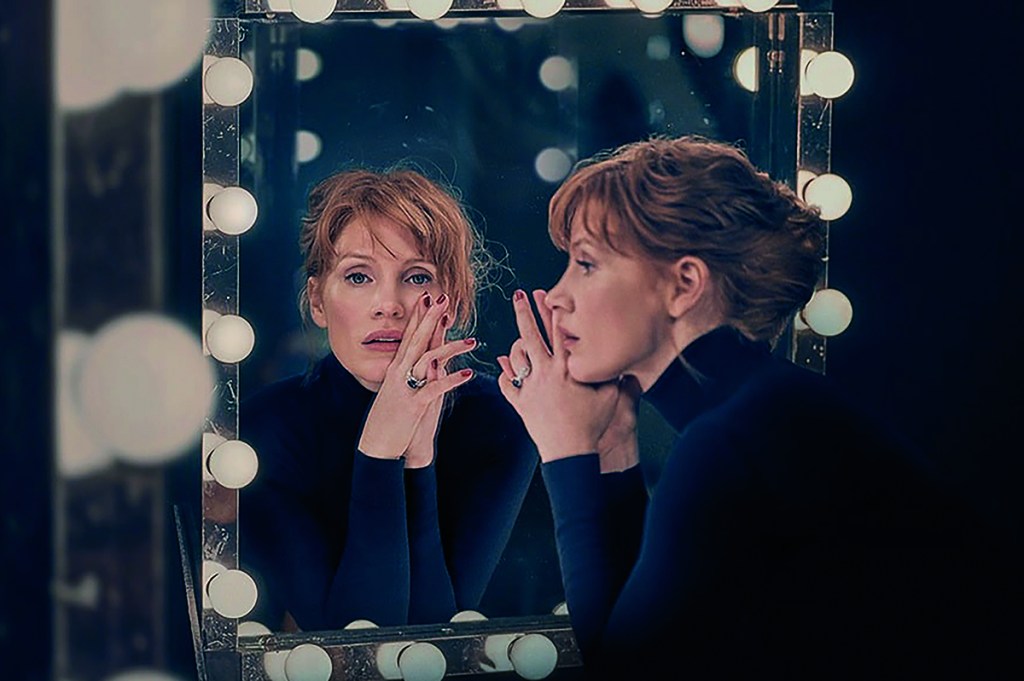The difference between a divorce and a funeral seems lost on the director Jamie Lloyd; ditto for bird cages and prisons and, in the end, Henrik Ibsen’s A Doll’s House (1879) and a sanatorium. Lloyd’s new, minimalist production on Broadway is so stripped of ornament, so unremittingly rote, that this reviewer nearly handed his valuables to an usher and asked for a padded room.
At the play’s close, the director has the embattled housewife, Jessica Chastain’s Nora Helmer, make her defiant exit through the back wall of the theater upstage; a garage door opens and she strides onto the rain-soaked pavement, probably to be harassed by tweakers or shoved into oncoming traffic. Peals of laughter erupted in the audience — here was our chance! — then some embarrassed hoots of applause, as the laden messaging sank in: this is her choice; here is her new life.
On which score you may discount Ibsen’s words about “fanatics of the women’s movement”; a man’s life is, after all, not synonymous with his art. But look to his stage directions, in which Nora’s final departure from Arian Moayed’s Torvald is signaled only by a door slamming offstage: consider what depths of feeling might be evoked in Torvald by that sound, and how succinctly, when you appraise Lloyd’s decision to wash it all away with a grand fourth-wall flourish.
Or discount altogether the question of whether Ibsen — that pioneer of naturalism — is a good candidate for minimalism. You may indeed hear A Doll’s House crying out for Very Modern Treatment. In his own day, Ibsen’s work sent shockwaves well beyond the proscenium; James Joyce called it an open question “whether any man has held so firm an empire over the thinking world in modern times.”
Ibsen mainly achieved this dominion through his late prose plays, fashioning an idiom that pitted traditional mores against contemporary notions of selfhood and fulfillment. A Doll’s House is the second of these, inspired by the plight of the playwright’s friend, the novelist Laura Kieler. It was hailed on many fronts as a clean draught of revolutionism, meant to upend the status quo: “an exploratory operation,” as one commentator glosses, “to lay bare the anatomy of a marriage where the wife was no more than a legal infant and her husband’s virtual slave.”
So you may deduce Ibsen’s protofeminism from the plot. Discount that Ibsen denied Kieler’s request for a loan at a critical juncture, whereupon her husband discovered she had forged a signature, divorced her and had her committed to an asylum. She had been funding her husband’s medical treatment, as in the play.
In any case, Ibsen’s Nora must grapple with a fabric of norms and customs, pressures and expectations, that are inevitably tailored and lost to his time. Lloyd’s Nora grapples with a set of anesthetized interlocutors, dark and mournful, as she rides around the rotating concentric floor panels that now denote her home. Since the only furnishings on the blank set are a few side chairs, the proceedings quickly resemble a carousel, not least when Nora and her creditor Nils Krogstad sit back-to-back on the same perch.
Thanks to this and other tortured blockings, dialogue is almost uniformly delivered with a dazed, quizzical affect — it’s hard to expect much else from actors who, pegged as stiff as boards and turned at all angles, don’t have gestures to respond to. (Likewise for playwright Amy Herzog’s new adaptation, which lives to see another day.) The notable exception is Michael Patrick Thornton, who saves a few scenes as Dr. Rank, the good-natured but despairing companion of the Helmers. Thornton lays a dry, smirking surface over a tender depth; the most moving moments in the production are Rank’s final entreaties to Nora, before he goes off to die. But in the lead role, I fear Jessica Chastain is terribly miscast. She plays it detached and hardened, not with the girlish boldness Torvald’s “birdie” calls for.
Which brings us back to bird cages and prisons. Some years before A Doll’s House, Ibsen began keeping a scorpion under a beer glass on his desk while he wrote. When it grew idle, he would toss it a morsel of fruit, which it would throttle violently. Then it would settle down again. A happy symbol for Ibsen’s activity — in art as in life, he had a venomous streak — but for present purposes, note how he sets up the little spectacle. To call the encasement a prison would not be quite right; it’s a question not of cruelty but optics. The glass is for display, so he could watch and goad its occupant. The scorpion might even recognize him. Like a bird in a cage, or a doll in a house.
This article was originally published in The Spectator’s April 2023 World edition.















